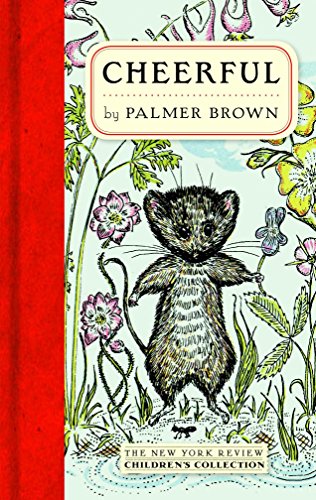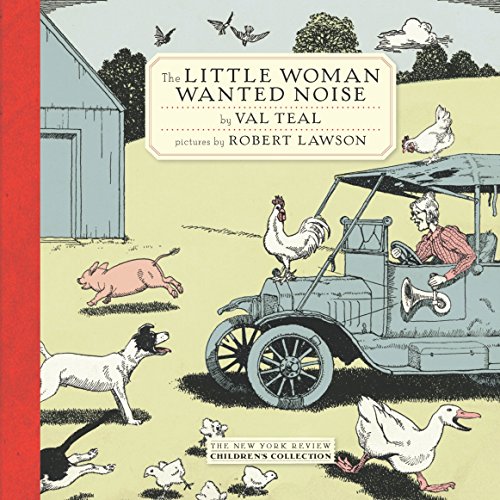-
Cheerful
Palmer Brown
Hardcover (NYR Children's Collection, Sept. 18, 2012)An Easter story for young readers. This is the tale of a little church mouse named Cheerful who lives in the city with his parents; his brother, Solemnity; and his sisters, Faith and Hope. Cheerful and his brother and sisters spend their time frolicking in the rainbow shadows cast by the church’s stained-glass windows and dining on the crumbs of wedding cakes. But while Solemnity, Faith, and Hope are happy to live in the bustling city, Cheerful’s favorite spot has always been the greenest patches of light under the windows. His dream is to settle in the country, and one day he bids his family farewell and sets off on an adventure.Palmer Brown’s intricate filigreed drawings turn this sweet, simple story into an instrument of enchantment as glorious as a rose window and as intimate as the spun-sugar Easter egg that will finally carry Cheerful to his pastoral home. M
M
-
The Two Cars
Ingri d'Aulaire, Edgar Parin d'Aulaire
Hardcover (NYR Children's Collection, Aug. 21, 2007)In The Two Cars the celebrated husband and wife team of Ingri and Edgar Parin d’Aulaire, famous for their illustrated versions of Norse and Greek myths, offer young children a playful modern twist on the ancient fable of the tortoise and the hare.Two cars sit side by side in the same garage. One is fast, shiny, and ready to go; the other is a comfortable old jalopy, a little worse for wear but as reliable as can be. On a magic moonlit night, the doors of the garage swing open and they head out for a spin, each determined to prove that he is the “best car on the road.” Over hill and dale and roundabout they go, encountering—and narrowly missing—trains, trucks, wildlife, and even, in the form of a policeman on a motorcycle, the long arm of the law. Before the two cars’ nocturnal caper is over, each will have discovered the being the “best” is not so simple as you might suppose. M
M
-
Terrible, Horrible Edie
E.C. Spykman
Hardcover (NYR Children's Collection, May 18, 2010)EVEN IF she has lived ten terrible years, terrible, horrible Edie really isn’t terrible and horrible at all, but rather one of the most charming and engaging and gutsy children in American children’s fiction. It’s true of course that Edie does get into—and not always without it being at least a little bit her fault—some pretty terrible and horrible scrapes, and that sometimes she will sulk, but these are the kinds of things that happen to the kid sister of two snooty boys and one fancy-pants girl, not to mention having to deal with the distraction of two half sisters who are no better than babies. Edie’s father and stepmother have headed to Europe for the summer, and though the rest of the family can look forward to good times at a beloved summer house on the sea, Edie still has to fight to hold her own. Adventures on a sailboat and on an island, and the advent of a major hurricane and what Edie takes to be a military coup, all come to a climax when Edie solves the mystery of who stole the neighbor’s jewels and saves, at least for one day, the day. This story of Edie and the other members of the Cares family may remind readers of Arthur Ransome’s Swallows and Amazons, except that Edie has an experimental, even anarchic streak that is all her terrible, horrible own. R
R
-
He Was There From the Day We Moved In
Rhoda Levine, Edward Gorey
Hardcover (NYR Children's Collection, Oct. 2, 2012)The naming of dogs can be a tricky business, as Ogdon and his big brother discover in this charming collaboration between Rhoda Levine and Edward Gorey. You see, before Ogdon and his family moved to a new house, no one mentioned the big shaggy sheep dog in the back yard, but there he was, just sitting and waiting, imperturbable as can be. Waiting for what? Ogdon wonders. Dinner? A lollipop? A stray cat? Someone to talk to? No, what the dog wants is a name. And not just any name, but the right name. And with a little patience, and a lot of persistence, Ogdon and his brother will figure it out. M
M
-
The Little Woman Wanted Noise
Val Teal, Robert Lawson
Hardcover (NYR Children's Collection, Sept. 24, 2013)A lost classic from the illustrator of The Story of Ferdinand and Mr. Popper’s Penguins.CLANG! THUMP! WHOOSH! BANG! The big city is a noisy place. But the little woman doesn’t mind, the big city is her home. Then one day she is given a wonderful gift, a “pleasant, peaceful farm” in the country. The farm is nearly perfect—only with all the quiet, the little woman can’t relax.So she buys a cow, she buys a dog, a cat and a duck, a rooster, a pig. Now the farm is noisy indeed. Still, something’s missing. She decides to return to the city for that one special thing she knows will make her farm feel just like home. And by the end of her tale the little woman is happy to find that even though she has no rest, she has peace of mind.Published only seven years after The Story of Ferdinand, The Little Woman Wanted Noise shows Robert Lawson at the peak of his talent and contains some of the most stunning and innovative black-and-white drawings in all of American picture-book history. They are the joyous accompaniment to Val Teal’s story, which reminds us that a life without a little chaos is no life at all. K
K
-
The Rescuers
Margery Sharp, Garth Williams
Hardcover (NYR Children's Collection, July 12, 2011)MISS BIANCA IS A WHITE MOUSE OF GREAT BEAUTY and supreme self-confidence, who, courtesy of her excellent young friend, the ambassador’s son, resides luxuriously in a porcelain pagoda painted with violets, primroses, and lilies of the valley. Miss Bianca would seem to be a pampered creature, and not, you would suppose, the mouse to dispatch on an especially challenging and extraordinarily perilous mission. However, it is precisely Miss Bianca that the Prisoners’ Aid Society picks for the job of rescuing a Norwegian poet imprisoned in the legendarily dreadful Black Castle (we all know, don’t we, that mice are the friends of prisoners, tending to their needs in dungeons and oubliettes everywhere). Miss Bianca, after all, is a poet too, and in any case she is due to travel any day now by diplomatic pouch to Norway. There Miss Bianca will be able to enlist one Nils, known to be the bravest mouse in the land, in a desperate and daring endeavor that will take them, along with their trusty companion Bernard, across turbulent seas and over the paws and under the maws of cats into one of the darkest places known to man or mouse. It will take everything they’ve got and a good deal more to escape with their own lives, not to mention the poet. Margery Sharp’s classic tale of pluck, luck, and derring-do is amply and beautifully illustrated by the great Garth Williams. S
S
-
Terrible, Horrible Edie
E.C. Spykman
Hardcover (NYR Children's Collection, May 18, 2010)EVEN IF she has lived ten terrible years, terrible, horrible Edie really isn’t terrible and horrible at all, but rather one of the most charming and engaging and gutsy children in American children’s fiction. It’s true of course that Edie does get into—and not always without it being at least a little bit her fault—some pretty terrible and horrible scrapes, and that sometimes she will sulk, but these are the kinds of things that happen to the kid sister of two snooty boys and one fancy-pants girl, not to mention having to deal with the distraction of two half sisters who are no better than babies. Edie’s father and stepmother have headed to Europe for the summer, and though the rest of the family can look forward to good times at a beloved summer house on the sea, Edie still has to fight to hold her own. Adventures on a sailboat and on an island, and the advent of a major hurricane and what Edie takes to be a military coup, all come to a climax when Edie solves the mystery of who stole the neighbor’s jewels and saves, at least for one day, the day. This story of Edie and the other members of the Cares family may remind readers of Arthur Ransome’s Swallows and Amazons, except that Edie has an experimental, even anarchic streak that is all her terrible, horrible own. R
R